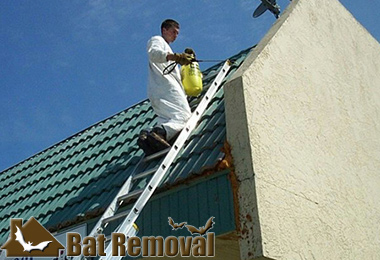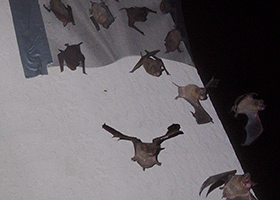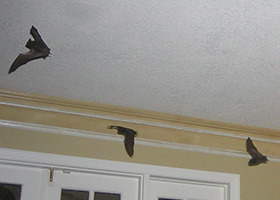Omaha Bat Removal
Welcome to Omaha Bat Removal! We are Nebraska bat removal specialists. It is important to know that bats are protected by Nebraska law, and are beneficial animals to have in the environment. We do not kill any bats during our bat removal process. Never hire a pest control company or anyone who says they are a Omaha bat exterminator. For correct and effective bat removal, you want a company that specializes in humane bat colony extraction. Our process is not only the only legal method in Nebraska, but it is the most effective. We have a 100% success rate in our bat control process. We perform our industry-best 32-point inspection of your house or building, and seal shut all bat entry holes down to 1/4 inch as part of the removal process, during which we remove the colony via special one-way exclusion devices specific to your architecture. Once all bats are safely out, we permanenetly bat-proof the structure. We also provide guano (bat droppings) removal and decon. Click on our Omaha Bat Control Prices page to find out more about our prices for bat control work. We work 24/7/365, and would love to talk to you about your bat problem. Call us any time at 402-999-4046 to discuss it, discuss our pricing, and if you wish, set up an appointment at your convenience, often same-day.

Omaha Building and Attic Inspections

No-kill Nebraska Bat Extraction

Guano Cleanouts - Serving all of Nebraska
Call 24/7 to discuss your bat problem.
Same-day or next-day appointments.
32-point inspection of your property.
Written estimates for bat removal project.
Fully state licensed and insured.
Residential and commercial service
100% no-kill Omaha bat extraction
Complete bat-proofing of your building
Compliance with all Nebraska, federal laws
Guano removal and attic decontamination
Our Service Range - 402-999-4046



Yearly Bat Activities
For those who fear bats, understand that the bats will be more fearful on the presence of humans. There are lots of misconception towards the bats. In reality, bats are important in keeping the balance of our ecosystem by eating the insects that destroy the crops. They are also pollinators and will fertilize soil with their guano. They will also help in spreading the seeds that promotes the growth of new trees. In this article, we will discuss the yearly activities of the bats.
January
During January, the bats will mostly be in a state of hibernation. They will be inactive since they will need to save their energy. This is being characterized through the lower temperature of the bats. Their heart beat and their breathing will also significantly slower.
February
In this month, the bats will still be in a state of torpor. They will probably have a small amount of body fat left. They will be leaving the roosting site soon especially during the warmer times in order to hunt for foods.
March
Around this time, the bats will start to emerge out of their hibernation colony. There will be signs of restricted activity. A small number of them will be foraging food as the temperature starts to become warmer. However, they may still enter a state of torpor if the weather becomes cold.
April
The hibernation period has already ended, and they are now feeling hungry and highly active. They will be feeding at night. They will be probably moving on their various roosting sites. For those who are found in the colder region, they may still go through a state of inactivity.
May
The bats will be active with their feeding. They are making up for the lost in their body fats. Female bats will form their maternity colony during this month. They must look for the suitable site to nurse their young ones. The male will be roosting separately to the female bats.
June
About this time, the bats will be giving birth to their pup. These baby bats will be feeding on milk. The size of the bats will not be more than an inch. Their grey fur will be thin and will appear naked. The mother bats will need to increase their insect's intake to properly nourish their baby bats.
July
On July, the mother bat will continue to nurse her young ones. The baby bats will be growing fast and some of them will be ready to leave the maternity colony soon. On some bat species, it will only take three weeks before they can leave the cave.
August
Now that the baby bats are already 6-week old, they now have the skills to hunt for their own food. They will no longer feed on their mother's milk. They will start to disperse, and the female bats will move to the mating colony.
September
This is the beginning of the mating season. The male bats will be doing a series of acrobatic stunts and produce calls to attract female bats. The bats will also start to build their body fat around this time.
October
Breeding season is still in effect. However, it is more crucial for the bats to increase their body fat. They are also starting to look for the suitable hibernation roost.
November
There are bats that will be going through a state of torpor. This will help them save their energy especially when it is difficult to find insects. They will be using their stored fats as their fuel.
December
The bats are already hibernating around this month. They may be roosting on small group or will be roosting alone. They should look for a site that is quiet and cools such as on caves, abandoned buildings, and mines.

